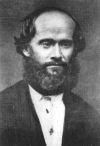King Strang
King Stang
 Born on March 21, 1813, in Scipio, N. Y., he was christened Jesse James Strang. As a young man he changed it to James Jesse. The short, stocky, stern, red-headed Strang was almost devoid of a sense of humor and had a great thirst for power.
Born on March 21, 1813, in Scipio, N. Y., he was christened Jesse James Strang. As a young man he changed it to James Jesse. The short, stocky, stern, red-headed Strang was almost devoid of a sense of humor and had a great thirst for power.
As an ardent Mormon, Strang was moving west with the main body of Latter-Day Saints in 1846 when he had a vision. In it he saw a "land amidst wide waters, and covered with large timber, with a deep, broad bay on one side of it."
Having heard of Beaver Island in northern Lake Michigan, Strang traveled there to inspect it with a few fellow Mormons and found a sparsely inhabited refuge. It seemed an ideal spot, offering isolation from the Gentiles as well as a splendid natural harbor, rich fishing grounds, and a port on the main steamship route to Chicago from all points on the Great Lakes. He encouraged his followers to settle the island.
Strang was a charismatic, able, and shrewd man, a born leader. With devious cunning, he amassed enough secret votes to get himself elected to the state legislature in 1852. He represented one fourth the area of Michigan.
Strang made himself guardian of the varied interests of his district. He secured the complete separation of Beaver Island from Michilimackinac County by incorporating it, along with Charlevoix County, into tiny Emmet County. He also organized Grand Traverse County and eight new townships. A judiciary and municipal government were provided for the whole district. His policy was to foster the fisheries as a source of profit for his people and use the power of political machinery to secure immunity for his flock from the laws of the Gentiles. By dictating to his followers through his own interpretation of Mormonism, and by manipulating the agencies of local government to control non-believers, Strang was the undisputed ruler of the northern part of lower Michigan. In a bizarre ceremony using Shakespearean theatrical props, he crowned himself king, the only one ever in the United States.
Strang took five wives. His followers convinced him that his first wife was not supportive enough of their cause, so he sent her off the island in 185l. His second wife traveled with him for almost a year disguised as his nephew and secretary under the name Charles Douglas. She became his queen on Coronation Day, July 8, 1850. (Their son, Charles, became editor/publisher of the Charlevoix Journal in 1883.) His third wife had told him she would be honored to be taken into the fold, so another marriage took place. Two more followed and he had children by all of them. After his death many of his survivors settled on the mainland and changed the Strang name to avoid trouble.
THE BATTLE OF PINE RIVER
Traders in those days commonly paid Indians with whiskey. In 1851 this became illegal, but the Mormons were the only ones to take the law seriously enough to enforce it. The free and easy fishermen at Pine River defied it, continuing to distribute liquor to the Native Americans with whom they traded. The sheriff of Strang's kingdom called at Pine River in the fall of 1852 to arrest renegades, but all the fishermen hid in the woods and no one was arrested.
Calm reigned until July 12, 1853, when the Mormon sheriff gathered two small boatloads of largely unarmed men and set sail for the mainland. His mission was to summon three fishermen whose names had been selected for jury duty at the principal island settlement, St. James, named after Strang.
The king's newspaper, the Northern IsLander, denigrated the mainlanders as "little else than a band of vagabonds and thieves." The mainlanders, who equally despised the Islanders, had long been promising to kill any Mormons who came over to serve papers.
The Mormons landed near the mouth of Pine River below the Park Avenue bluff. When confronted, they claimed they were not there to make threats but to serve the subpoenas. The fishermen refused to hand the three men over and advised the Mormons to leave at once. What happened next cannot be determined because of too many conflicting accounts. The only circumstances known for sure are that a shot was fired that triggered a hail of lead from the bluff, mainlander Louis Gebo was shot in the knee, and the Mormons fled with their wounded.
The fishermen pursued the Mormons for eight miles until they caught up with them and opened fire. Good fortune saved the Mormons in the form of the becalmed bark Morgan. They pleaded to be taken aboard. The Morgan's Captain Stone refused to turn the rescued men over, so the mainlanders headed for home. Fearing Mormon vengeance, they soon abandoned the area. Pine River became a ghost town.
The Mormons had been expanding over the region until June of 1856 when Strang's dictatorial ways caught up with him. The Mormon vision came to a violent close. Two maltreated followers, Thomas Bedford and Alexander Wentworth, hid on the dock at St. James and shot him. Strang survived for a time on the island, then died at his parents' home in Wisconsin on July 9th. The leaderless Island Mormons, knowing invasion forces were now massing against them at Mackinac, fled. Those who did stay in the area maintained a low profile.
If Strang had lived, northern Michigan may well have become a strongly Mormon territory comparable to Brigham Young's achievement in Utah. Within six years, he had attracted over 2500 followers to a remote Lake Michigan island. Daily, boats had crossed from St. James to Pine River bringing settlers who were populating the Pine Lake region and crossing south into Antrim County. Strang had even christened Pine Lake as Lake Mormon. The roots were beginning to take hold. But at his death the autocrat's power base crumbled and his utopian experiment gradually disintegrated.


